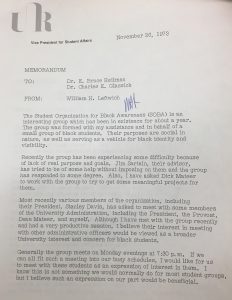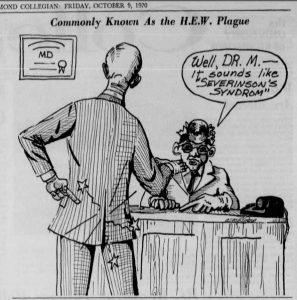People say that talking about race is hard, but is it really? This week on Expanding the Ivory Tower Victoria explores a “Racial Awareness Session” that took place on campus in 1971 involving students from the University of Richmond and Virginia Union University, a nearby historically black university. During the session the students were prompted to ask questions of themselves and each other through the lens of race and racism.
Month: October 2016
This Week in the Archive: SOBA Memo
 On November 26, 1973 then-vice president of student affairs, William H. Leftwich, sent a memo to university president, Dr. E. Bruce Heilman and provost, Dr. Charles H. Glassick, concerning the Student Organization for Black Awareness (SOBA). According to Leftwich, SOBA had been in existence for about a year and was formed with his help and continued under the guidance of sociology professor Dr. James Sartain. Leftwich noted that the group aimed to serve as a “vehicle for black identity and visibility” on campus but in his opinion lacked “real purpose and goals.” Despite having stated the group’s purpose in the previous paragraph, Leftwich’s assertion that the group lacked real purpose suggests that he did not consider their claims to a shared identity as a legitimate cause for group formation. In the memo Leftwich added that he had asked Richard Mateer, the dean of Richmond College, to help the group get some “meaningful projects” off the ground.
On November 26, 1973 then-vice president of student affairs, William H. Leftwich, sent a memo to university president, Dr. E. Bruce Heilman and provost, Dr. Charles H. Glassick, concerning the Student Organization for Black Awareness (SOBA). According to Leftwich, SOBA had been in existence for about a year and was formed with his help and continued under the guidance of sociology professor Dr. James Sartain. Leftwich noted that the group aimed to serve as a “vehicle for black identity and visibility” on campus but in his opinion lacked “real purpose and goals.” Despite having stated the group’s purpose in the previous paragraph, Leftwich’s assertion that the group lacked real purpose suggests that he did not consider their claims to a shared identity as a legitimate cause for group formation. In the memo Leftwich added that he had asked Richard Mateer, the dean of Richmond College, to help the group get some “meaningful projects” off the ground.
After introducing SOBA, Leftwich went on to ask, on behalf of the group, if Heilman and Glassick would be willing to meet with them. He acknowledged that student meetings with administrators were not typical but emphasized that it “would be viewed as a broader University interest and concern for black students.” Leftwich presented the meeting as a symbolic gesture and did not indicate that it would be anything beyond “an expression of interest.” It is interesting that Leftwich posited the meeting as a mere expression of interest in black students even though high-level administrators were invited to participate in the conversation. As president, Dr. Heilman in particular had the authority to bring about broad-sweeping change to the university or at the very least present possible changes to the Board of Trustees. His presence at the meeting had the power to be more than symbolic.
The proposed meeting offered a chance to hear directly from black students, implement new policies, and make the university better but instead that opportunity was squandered for the sake of symbolism. It is great that black students had the chance to be heard but it seems as though their grievances might have fallen on deaf ears. The demographic composition of the proposed meeting showed an inherent defect in the university system. All of the invited administrators were white men. At the time there were no full-time black faculty or high-level staff at the school. Black students were made to plead their case to those who may have been sympathetic to their cause but not at all familiar with their struggle. This memo implies that the administration was unwilling to seriously consider the plight of black students at the school and instead chose to make symbolic concessions.
Let’s Push Back
This week on Expanding the Ivory Tower we consider two articles, one written in 1973 and the other in 2016, that chronicle black students’ critiques of the university.
This Week in the Archive: The HEW Plague
 This image appeared in the October 9, 1970 edition of The Collegian, the student newspaper at the University of Richmond. The cartoon depicts Dr. George Modlin, former university president, pointing to what seems to be a pain in his backside. The doctor in the cartoon diagnoses Modlin with a fictional ailment referred to as Severinson’s Syndrome. The image caption explains that the ailment is also “commonly known as the HEW Plague.” In effect, the cartoon implies that Severinson’s Syndrome or the more commonly the HEW Plague is what’s causing the pain in Dr. Modlin’s backside.
This image appeared in the October 9, 1970 edition of The Collegian, the student newspaper at the University of Richmond. The cartoon depicts Dr. George Modlin, former university president, pointing to what seems to be a pain in his backside. The doctor in the cartoon diagnoses Modlin with a fictional ailment referred to as Severinson’s Syndrome. The image caption explains that the ailment is also “commonly known as the HEW Plague.” In effect, the cartoon implies that Severinson’s Syndrome or the more commonly the HEW Plague is what’s causing the pain in Dr. Modlin’s backside.
Severinson’s Syndrome alludes to Dr. Eloise Severinson, the regional civil rights director for the now-defunct Department of Health, Education and Welfare (HEW). Appointed to the position in 1968, Dr. Severinson was tasked with helping institutions comply with Title VI of the Civil Rights Act of 1964, which prohibited discrimination on the basis of race, color, or national origin in any program receiving federal funding. In October of 1970 Dr. Severinson wrote a letter to Dr. Modlin expressing her belief that the University of Richmond still projected “an image of an exclusive all-white Southern institution.” Since the University had begun accepting federal aid several years prior, Severinson maintained that HEW could stop funding the University if it was not in compliance with the law. In the letter Severinson offered numerous solutions to the problem including the admission of more high-risk students, the hiring of black administrators, and cooperation with historically black colleges and universities in the area such as Virginia Union University. Severinson also advocated the use of more black students in the recruitment process along with an augmented interest in recruiting blacks students.
President Modlin declined to comment on the subject of the letter and instead told the Richmond Times-Dispatch that he would “take the matter up with the board of trustees later” in the month. The cartoon reflected student perception of Modlin’s lackadaisical attitude toward Severinson’s letter. His lack of comment made it seem as though the letter served as an annoyance to be ignored rather than an impassioned call to action. Further, Modlin’s complicit acceptance of the racial status quo at the University was inherently racist because it effectively shut minorities out of educational opportunities. His silence on the matter actually speaks volumes to the lack of commitment to racial equity on the part of university administrators at the time. They essentially had to be strong-armed into compliance with the Civil Rights Act and when prodded they erred on the side of inaction.
Making the Invisible Visible: Activating Black History Through Digital Storytelling
Please join us Thursday, October 6, from 3-4:30pm, at VCU’s Cabell Library for a panel connecting digital humanities projects and black history collections. Speakers from Umbra: Search African American History, VCU Library’s Mapping the Second KKK Project, and the University of Richmond’s Digital Scholarship Lab and Race & Racism Project will connect library and archive work in black collections to digital projects from students, faculty, and community members. This panel will be moderated by Kelley Libby of the WVTF/Radio IQ/Finding America’s UnMonumental radio series. Refreshments will be provided!
For more details and to RSVP for this excellent event, see here.
